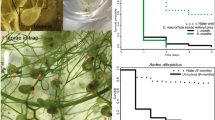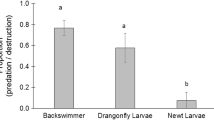Abstract
Larvae of the predatory mosquito Toxorhynchites rutilus consume arthropods within container habitats, including native Aedes triseriatus and invasive Aedes japonicus mosquitoes. Previous studies, which did not account for common habitat attributes such as habitat structure and predation cues, conflict on whether Ae. triseriatus and Ae. japonicus differ in their vulnerability to predation. We conducted two laboratory experiments to assess how habitat attributes modulate Tx. rutilus predation on Ae. triseriatus and Ae. japonicus. In experiment one, we added fine particulate organic matter (FPOM) and assessed vulnerability for each species separately. Experiment two contained the following treatments: presence/absence of predation cues, presence/absence of habitat structure (FPOM and leaves) and three species combinations: Ae. triseriatus or Ae. japonicus alone, and both species together. We added one Tx. rutilus to feed in each microcosm for 24 h (experiment one and two) and until all prey were consumed (experiment two only). When reared alone, Ae. triseriatus had higher survival compared to Ae. japonicus in experiment one (71% vs. 52%) but there were no significant differences at 24 h in experiment two. When we followed the cohort to total predation, Ae. triseriatus had a lower daily survival rate compared to Ae. japonicus (hazard ratio 1.165) when the species were kept separately. When the species were mixed, however, Ae. japonicus was more vulnerable than Ae. triseriatus (hazard ratio 1.763), prolonging Ae. triseriatus time to total cohort predation. Both species were less likely to be consumed in the presence of predation cues. We detected no effect of habitat structure. These results demonstrate vulnerability is context dependent and the presence of an invasive congener can relax predation pressure on a native prey species when they co-occur in the same habitat.



Similar content being viewed by others
Data availability
The data presented in this manuscript is publically available at http://doi.org/10.5061/dryad.j9kd51ch5.
References
Albeny-Simões D, Murrell EG, Elliot SL, Andrade MR, Lima E, Juliano SA, Vilela EF (2014) Attracted to the enemy: Aedes aegypti prefers oviposition sites with predator-killed conspecifics. Oecologia 175:481–492. https://doi.org/10.1007/s00442-014-2910-1
Alto BW (2011) Interspecific larval competition between invasive Aedes japonicus and native Aedes triseriatus (Diptera: Culicidae) and adult longevity. J Med Entomol 48:232–242. https://doi.org/10.1603/ME09252
Alto BW, Griswold MW, Lounibos LP (2005) Habitat complexity and sex-dependent predation of mosquito larvae in containers. Oecologia 146:300–310. https://doi.org/10.1007/s00442-005-0198-x
Anton A, Geraldi NR, Ricciardi A, Dick JTA (2020) Global determinants of prey naiveté to exotic predators. Proc Royal Soc B. https://doi.org/10.1098/rspb.2019.2978
Bradshaw WE, Holzapfel CM (1983) Predator-mediated, non-equilibrium coexistence of tree-hole mosquitoes in southeastern North America. Oecologia 57:239–256. https://doi.org/10.1007/BF00379586
Campos RLE, Lounibos LP (2000) Natural prey and digestion times of Toxorhynchites rutilus (Diptera: Culicidae) in Southern Florida. Ann Entomol Soc Am 93:1280–1287. https://doi.org/10.1603/0013-8746(2000)093[1280:NPADTO]2.0.CO;2
Chandrasegaran K, Juliano SA (2019) How do trait-mediated non-lethal effects of predation affect population-level performance of mosquitoes? Front Ecol Evol. https://doi.org/10.3389/fevo.2019.00025
Chivers DP, Wildy EL, Kiesecker JM, Blaustein AR (2001) Avoidance response of juvenile Pacific treefrogs to chemical cues of introduced predatory bullfrogs. J Chem Ecol 27:1667–1676. https://doi.org/10.1023/a:1010418526991
Colautti RI, Ricciardi A, Grigorovich IA, MacIsaac HJ (2004) Is invasion succes explained by the enemy release hypothesis? Ecol Lett 7:721–733. https://doi.org/10.1111/j.1461-0248.2004.00616.x
Costanzo KS, Muturi EJ, Alto BW (2011) Trait-mediated effects of predation across life-history stages in container mosquitoes. Ecol Entomol 36:605–615. https://doi.org/10.1111/j.1365-2311.2011.01302.x
DeBoom CS, Wahl DH (2013) Effects of coarse woody habitat complexity on predator–prey interactions of four freshwater fish species. Trans Am Fish Soc 142:1602–1614. https://doi.org/10.1080/00028487.2013.820219
DeCarlo CH, Campbell SR, Bigler LL, Mohammed HO (2020) Aedes japonicus and West Nile virus in New York. J Am Mosq Control Assoc 36:261–263. https://doi.org/10.2987/20-6958.1
Freed TZ, Kesavaraju B, Leisnham PT (2014) Effects of competition and predation by native mosquitoes on the North American invasion of Aedes japonicus japonicus (Diptera: Culicidae). J Med Entomol 51:1159–1167. https://doi.org/10.1603/ME13179
Gallitano S, Blaustein L, Vonesh J (2006) First occurrence of Ochlerotatus japonicus in Missouri. J Vector Ecol 30:347–348
Grill CP, Juliano SA (1996) Predicting species interactions based on behaviour: predation and competition in container-dwelling mosquitoes. J Anim Ecol 65:63–76. https://doi.org/10.2307/5700
Griswold MW, Lounibos LP (2006) Predator identity and additive effects in a treehole community. Ecology 87:987–995. https://doi.org/10.1890/0012-9658(2006)87[987:PIAAEI]2.0.CO;2
Heger T, Jeschke JM (2014) The enemy release hypothesis as a hierarchy of hypotheses. Oikos 123:741–750. https://doi.org/10.1111/j.1600-0706.2013.01263.x
Holt RD, Lawton JH (1994) The ecological consequences of shared natural enemies. Annu Rev Ecol Syst 25:495–520
Juliano SA (2009) Species interactions among larval mosquitoes: context dependence across habitat gradients. Annu Rev Entomol 54:37–56. https://doi.org/10.1146/annurev.ento.54.110807.090611
Juliano SA, Gravel ME (2002) Predation and the evolution of prey behavior: an experiment with tree hole mosquitoes. Behav Ecol 13:301–311. https://doi.org/10.1093/beheco/13.3.301
Juliano SA, Reminger L (1992) The relationship between vulnerability to predation and behavior of larval treehole mosquitoes: geographic and ontogenetic differences. Oikos 63:465–476. https://doi.org/10.2307/3544974
Juliano SA, Westby KM, Ower GD (2019) Know your enemy: effects of a predator on native and invasive container mosquitoes. J Med Entomol 56:320–328. https://doi.org/10.1093/jme/tjy196
Kaufman MG, Fonseca DM (2014) Invasion biology of Aedes japonicus japonicus (Diptera: Culicidae). Annu Rev Entomol 59:31–49. https://doi.org/10.1146/annurev-ento-011613-162012
Kaufman MG, Chen S, Walker ED (2008) Leaf-associated bacterial and fungal taxa shifts in response to larvae of the tree hole mosquito, Ochlerotatus triseriatus. Microb Ecol 55:673–684. https://doi.org/10.1007/s00248-007-9310-6
Kesavaraju B, Juliano SA (2004) Differential behavioral responses to water-borne cues to predation in two container-dwelling mosquitoes. Ann Entomol Soc Am 97:194–201. https://doi.org/10.1603/0013-8746(2004)097[0194:DBRTWC]2.0.CO;2
Kesavaraju B, Juliano SA (2010) Nature of predation risk cues in container systems: mosquito responses to solid residues from predation. Ann Entomol Soc Am 103:1038–1045. https://doi.org/10.1603/AN10007
Kesavaraju B, Damal K, Juliano SA (2007) Threat-sensitive behavioral responses to concentrations of water-borne cues from predation. Ethology 113:199–206. https://doi.org/10.1111/j.1439-0310.2006.01317.x
Kesavaraju B, Khan DF, Gaugler R (2011) Behavioral differences of invasive container-dwelling mosquitoes to a native predator. J Med Entomol 48:526–532. https://doi.org/10.1603/me10200
Klecka J, Boukal DS (2014) The effect of habitat structure on prey mortality depends on predator and prey microhabitat use. Oecologia 176:183–191. https://doi.org/10.1007/s00442-014-3007-6
Lima SL, Dill LM (1990) Behavioral decisions made under the risk of predation: a review and prospectus. Can J Zool 68:619–640. https://doi.org/10.1139/z90-092
Linley JR (1995) Behavior on approach to surface prey by larvae of Toxorhynchites amboinensis and Tx. brevipalpis (Diptera: Culicidae). J Med Entomol 32:53–65. https://doi.org/10.1093/jmedent/32.1.53
Linley JR, Darling K (1993) Search behavior associated with egg cannibalism in Toxorhynchites amboinensis and Toxorhynchites rutilus rutilus (Diptera: Culicidae). J Med Entomol 30:561–570. https://doi.org/10.1093/jmedent/30.3.561
Maciá A, Bradshaw WE (2000) Seasonal availability of resources and habitat degradation for the western tree-hole mosquito, Aedes sierrensis. Oecologia 125:55–65. https://doi.org/10.1007/PL00008891
McIntire K, Juliano SA (2018) How can mortality increase population size? A test of two mechanistic hypotheses. Ecology 99:1660–1670. https://doi.org/10.1002/ecy.2375
Mennen GJ, Laskowski KL (2018) Defence is the best offence: invasive prey behaviour is more important than native predator behaviour. Anim Behav 138:157–164. https://doi.org/10.1016/j.anbehav.2018.02.017
Michel MJ, Adams MM (2009) Differential effects of structural complexity on predator foraging behavior. Behav Ecol 20:313–317. https://doi.org/10.1093/beheco/arp005
Murrell EG, Juliano SA (2013) Predation resistance does not trade off with competitive ability in early-colonizing mosquitoes. Oecologia 173:1033–1042. https://doi.org/10.1007/s00442-013-2674-z
Narimanov N, Hatamli K, Entling MH (2021) Prey naïveté rather than enemy release dominates the relation of an invasive spider toward a native predator. Ecol Evol 11:11200–11206. https://doi.org/10.1002/ece3.7905
O’Donnell DL, Armbruster P (2007) Comparison of larval foraging behavior of Aedes albopictus and Aedes japonicus (Diptera: Culicidae). J Med Entomol 44:984–989. https://doi.org/10.1603/0022-2585(2007)44[984:colfbo]2.0.co;2
Pintor LM, Byers JE (2015) Do native predators benefit from non-native prey? Ecol Lett 18:1174–1180. https://doi.org/10.1111/ele.12496
Russo RJ (1983) The functional response of Toxorhynchites rutilus rutilus (Diptera: Culicidae), a predator on container-breeding mosquitoes. J Med Entomol 20:585–590. https://doi.org/10.1093/jmedent/20.6.585
Saha N, Aditya G, Saha GK (2009) Habitat complexity reduces prey vulnerability: an experimental analysis using aquatic insect predators and immature Dipteran prey. J Asia Pac Entomol 12:233–239. https://doi.org/10.1016/j.aspen.2009.06.005
Sih A (1986) Antipredator responses and the perception of danger by mosquito larvae. Ecology 67:434–441. https://doi.org/10.2307/1938587
Skein L, Robinson TB, Alexander ME (2018) Impacts of mussel invasions on the prey preference of two native predators. Behav Ecol 29:353–359. https://doi.org/10.1093/beheco/arx172
Skiff JJ, Yee DA (2014) Behavioral differences among four co-occurring species of container mosquito larvae: Effects of depth and resource environments. J Med Entomol 51:375–381. https://doi.org/10.1603/ME13159
Soto T (1996) Effects of capacity on resource input and the aquatic metazoan community structure in phytotelmata. Res Popul Ecol 38:65–73. https://doi.org/10.1007/BF02514972
Steffan WA, Evenhuis NL (1981) Biology of Toxorhynchites. Annu Rev Entomol 26:159–181. https://doi.org/10.1146/annurev.en.26.010181.001111
Sunahara T, Ishizaka K, Mogi M (2002) Habitat size: a factor determining the opportunity for encounters between mosquito larvae and aquatic predators. J Vector Ecol 27:8–20
Twining JP, Ian Montgomery W, Price L, Kunc HP, Tosh DG (2020) Native and invasive squirrels show different behavioural responses to scent of a shared native predator. Royal Soc Open Sci. https://doi.org/10.1098/rsos.191841
Westby KM, Fritzen C, Paulsen D, Poindexter S, Moncayo AC (2015) La Crosse encephalitis virus infection in field-Collected Aedes albopictus, Aedes japonicus, and Aedes triseriatus in Tennessee. J Am Mosq Control Assoc 31:233–241. https://doi.org/10.2987/moco-31-03-233-241.1
Westby KM, Sweetman BM, Van Horn TR, Biro EG, Medley KA (2019) Invasive species reduces parasite prevalence and neutralizes negative environmental effects on parasites in a native mosquito. J Anim Ecol 88:1215–1225. https://doi.org/10.1111/1365-2656.13004
Westby KM, Juliano SA, Medley KA (2021) Aedes albopictus (Diptera: Culicidae) has not become the dominant species in artificial container habitats in a temperate forest more than a decade after establishment. J Med Entomol 58:950–955. https://doi.org/10.1093/jme/tjaa215
Yee DA, Kaufman MG, Juliano SA (2007) The significance of ratios of detritus types and micro-organism productivity to competitive interactions between aquatic insect detritivores. J Anim Ecol 76:1105–1115. https://doi.org/10.1111/j.1365-2656.2007.01297.x
Zuharah WF, Fadzly N, Yusof NA, Dieng H (2015) Risky behaviors: effects of Toxorhynchites splendens (Diptera: Culicidae) predator on the behavior of three mosquito species. J Insect Sci 15:128. https://doi.org/10.1093/jisesa/iev115
Acknowledgements
We would like to thank Brenden Sweetman, Thomas Van Horn, Hanna Peterman, Leslie Sterling, and Delilah Sayer for laboratory and field assistance, Katie Costanzo for advice on experimental design, and Susan Flowers for student program support. This work was funded by Tyson Research Center.
Author information
Authors and Affiliations
Corresponding author
Ethics declarations
Conflict of interest
The authors declare no conflicts of interest.
Additional information
Publisher's Note
Springer Nature remains neutral with regard to jurisdictional claims in published maps and institutional affiliations.
Rights and permissions
Springer Nature or its licensor (e.g. a society or other partner) holds exclusive rights to this article under a publishing agreement with the author(s) or other rightsholder(s); author self-archiving of the accepted manuscript version of this article is solely governed by the terms of such publishing agreement and applicable law.
About this article
Cite this article
Beckermann, A.J., Medley, K.A., Adalsteinsson, S.A. et al. The final countdown: presence of an invasive mosquito extends time to predation for a native mosquito. Biol Invasions 25, 2507–2517 (2023). https://doi.org/10.1007/s10530-023-03051-1
Received:
Accepted:
Published:
Issue Date:
DOI: https://doi.org/10.1007/s10530-023-03051-1




